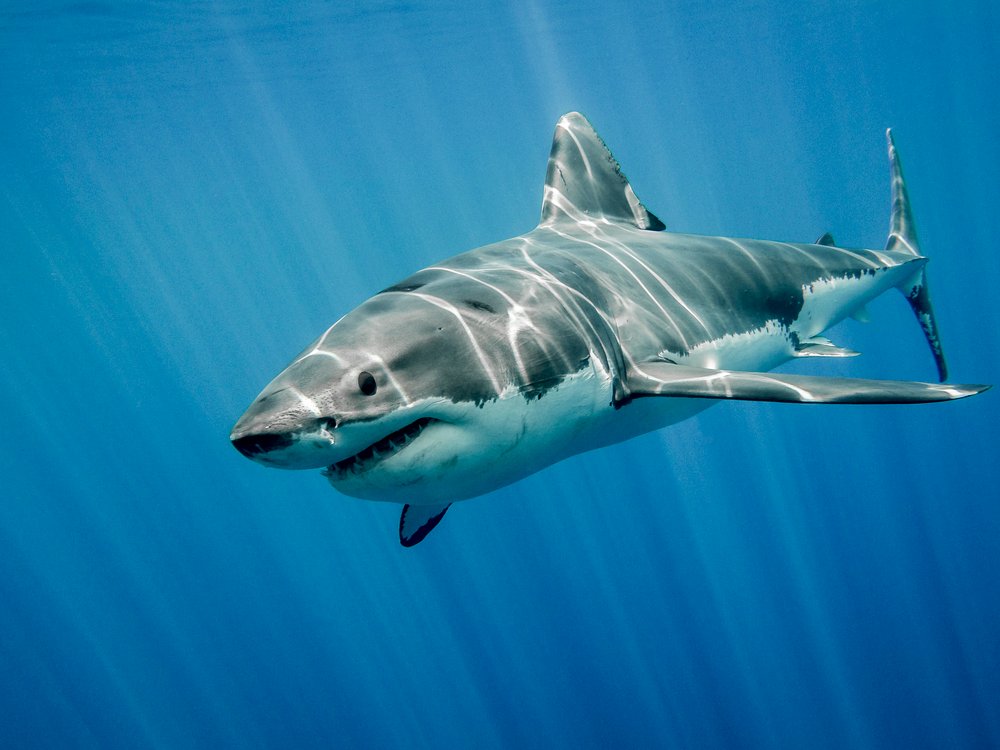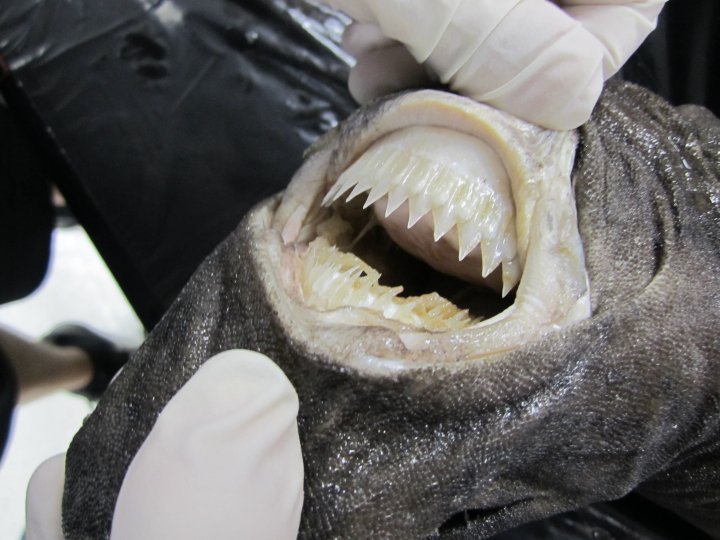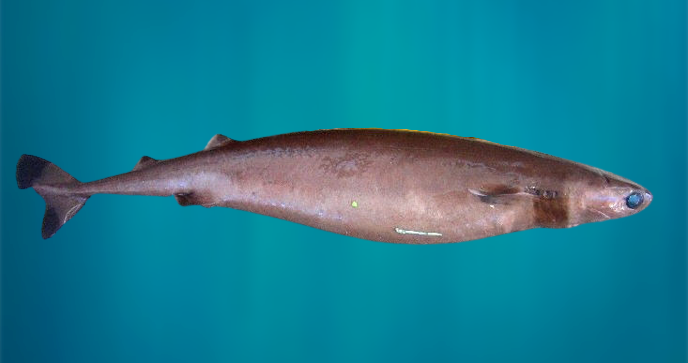Cookiecutter Shark Facts, Pictures & Submarine Attacks (Are They Dangerous?)

The cookiecutter shark, also known as the cigar shark, is a small but ferocious predator that gets its name from its ability to take circular bites out of its prey. It is found in tropical and temperate waters worldwide and can grow up to 16 to 20 inches in length.
While its size may be small, the cookiecutter shark is a fierce hunter. It has long, sharp teeth that it uses to bite into its prey and then twist its body to tear off a chunk of flesh. This hunting method allows the cookiecutter shark to prey on larger animals, including dolphins, whales, and even great white sharks.
The cookiecutter shark is a fascinating animal not only because of its hunting methods but also because of its life cycle. Females presumably give birth where the offspring are born with their teeth fully developed and ready to hunt immediately, as they don’t receive help from their mother.
While the cookiecutter shark may not be the largest or most well-known predator in the ocean, it is undoubtedly a fascinating and vicious creature.
Family Tree
The cookiecutter shark’s scientific name is isistius brasiliensis, one of the few isistius genus in the Dalatiidae family, which belongs to the larger dogfish shark order Squalidae or Squaliformes. These are classified as Chondrichthyes.
Chondrichthyes are cartilaginous fish, meaning their skeleton consists of cartilage for the most part. Cartilage is a smooth and resilient type of connective tissue that is not as hard and rigid as bone but much stiffer and less flexible than muscle.
The Chondrichthyes class has two subclasses known as Elasmobranchii and Holocephali. The first consists of sharks, skates, rays, and sawfish, and the latter subclass includes Chimaeras (ghost sharks) and Callorhinchus (elephantfish).
Habitat

The shark’s habitat is the warm tropical and subtropical waters of the Pacific, Atlantic, and Indian Oceans.
The world’s largest concentration of cookiecutter sharks is in the ocean surrounding Hawaii. Still, they may exist in significant numbers in more remote oceans than we know.
The small shark follows a diel cycle, meaning it migrates vertically from deep waters toward the surface during nighttime. It typically lives between 1000 and 200 meters in depth and sometimes as low as 3000 meters.
Characteristics
The cookiecutter shark has a cylindrical, cigar-shaped body with a long, blunt snout and large eyes. The first dorsal fin is small and originates over the rear half of the pelvic fins, and the second dorsal fin and the anal fin are absent.
The body of the cookiecutter shark is dark brown or black on top and white below. It often has a light-colored band on the flanks just behind the pectoral fins. The mouth’s interior is also light-colored, with scary rows of white teeth.
Sharp teeth
The shark is known for its sharp teeth. There are 35–38 teeth in the upper jaw and 31–34 teeth in the lower jaw, and its lower teeth are more prominent than its upper teeth.
One of the most interesting facts about the cookiecutter shark is that it replaces the whole set of its teeth multiple times throughout its lifetime instead of one tooth at a time.
The cookiecutter shark got its name after the cookie-shaped wounds it leaves on its prey’s bodies by biting.
Bioluminescent organism

The cookiecutter shark can glow in the dark water because it has photophores on its belly, which are organs that produce light and make it luminous and glow in the dark.
The process where living organisms produce and emit light is called bioluminescence, a chemical reaction of energy production inside the animal.
Scientists still need to discover what evolutionary advantage this function has. A few theories suggest it may scare away predators, communicate with other animals, attract prey or detect prey. Firefly is another example of a bioluminescent organism.
Another phenomenon, known as biofluorescence, is where organisms absorb, transform and emit light in another color than it was absorbed.
Preying behaviors of cookiecutter sharks

The cookiecutter shark terrorizes all sea animals, and nobody is safe. Their hunting style is unique. They can disguise themselves as small harmless fish, sneak up on their prey and take small bites of larger fish in passing, or hunt on shoals of fish.
They munch on larger animals like whales, swordfish, and even great white sharks. Large sea animals may carry scars or wounds from being prey to these small dogfish sharks.
Smaller fish can sustain injuries from the bites, enough to disable their swimming ability. As a result, they sink and end up as prey to predators.
Attacks on humans
Experts consider the cookiecutter sharks harmless because they rarely have attacked humans.
While their bites cause nasty flesh wounds, their size is too small to cause a real threat. Also, their habitat is deep in the sea during the daytime, so humans are unlikely to encounter them naturally.
The International Shark Attack File only knows of four reports of unprovoked attacks, all of which took place in Hawaii.
Attacks on submarines

There have been instances where the cookiecutter shark has attacked submarines by biting the rubber dome that covers the radars.
The US Navy started covering the rubber domes with plastic to protect them from bites.
Frequently Asked Questions
Are cookiecutter sharks dangerous?
No, cookiecutter sharks are not considered dangerous to humans and are relatively harmless. While a few unprovoked attacks on humans in Hawaii have been reported, their small vicious bites cause wounds. Still, they are not severe enough to have led to fatalities. Also, the shark’s usual habitat is deep in the ocean, so humans rarely have close encounters with them.
Can you keep a cookiecutter shark in an aquarium?
No. The shark is a midwater species and lives in a deep-sea environment. They have evolved in the dark and the pressure of those depths and struggle to acclimate to other habitats.
Previous attempts to acclimate these sharks to live in tanks or aquariums have failed, as acclimation is difficult. In such environments, deep-sea vertebrates do not live longer than a few days or weeks.
Cookiecutter sharks pictures
 Cooke Cutter Shark by JSUBiology, licensed under CC BY 2.0
Cooke Cutter Shark by JSUBiology, licensed under CC BY 2.0 Cookie Cutter Shark Bites by Jerry Kirkhart, licensed under CC BY 2.0
Cookie Cutter Shark Bites by Jerry Kirkhart, licensed under CC BY 2.0

